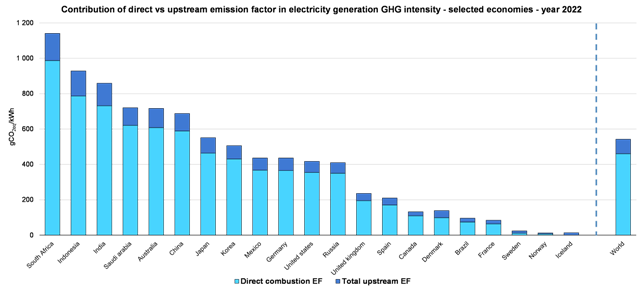The International Energy Agency (IEA) announced that it is preparing to release two data publications: the Life Cycle Upstream Emission Factors (2024) and the Emissions Factors Database (2024).
IEA says these releases aim to offer insights into the emissions intensities linked to global power generation and consumption, including both direct and life cycle-based greenhouse gas (GHG) emissions.
IEA Life Cycle Upstream Emission Factors (2024)
While low-carbon energy technologies generate no direct emissions at the point of electricity generation, emissions do occur throughout their life cycle. The IEA’s Life Cycle Upstream Emission Factors database takes a comprehensive approach by assessing the full climate impact of electricity systems, which helps illuminate potential emissions shifts along supply chains. Following a pilot phase, this dataset is now available as a standalone Excel database covering data from 2015 to the most recent year, spanning around 150 countries.
Key data includes:
Total Upstream Emission Factors (CO2eq/kWh): Representing emissions intensity from electricity generation, excluding direct combustion emissions.
Fuel-Cycle Emission Factors (CO2eq/kWh): Focused on emissions from fuel sources like fossil fuels, uranium, and biofuels.
Life Cycle Adjustment Factors for Transmission and Distribution Losses (CO2eq/kWh): Incorporating emissions tied to electricity loss during transmission and distribution.
IEA says this data is imporant for companies reporting Scope 3 emissions under the GHG Protocol, providing transparency into the full carbon footprint of electricity consumption.
IEA Emissions Factors (2024)
The IEA’s Emissions Factors Database focuses on direct emission intensities tied to both power generation and final energy use, offering country-specific data on global emissions. The data set, essential for reporting Scope 2 (location-based) and Scope 1 (fuel combustion) emissions under the GHG Protocol, also includes fuel-specific combustion factors.
For 2022, the global average emission factor at the generation point was 462 gCO2eq/kWh, with an upstream factor of 82 gCO2eq/kWh (about 18 percent of the direct emission factor). Countries such as Iceland and Sweden, with large shares of low-carbon energy sources, show upstream factors that exceed direct emissions at the generation point, underscoring the need for life cycle-based emissions assessments.
Upcoming Developments
To further enhance transparency, the IEA plans to introduce monthly and quarterly grid emission factors by November 2024. This initiative will provide near-real-time data from 2015 to mid-2024 for 50 countries, helping users better track emissions trends.
These releases are poised to support businesses and policymakers in making more informed decisions around electrification and emissions reporting, offering a clearer picture of the carbon impact of electricity systems globally.

